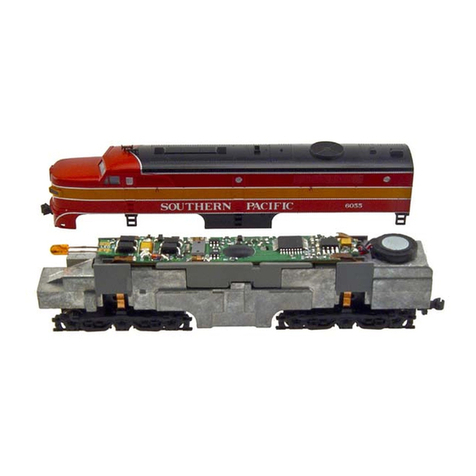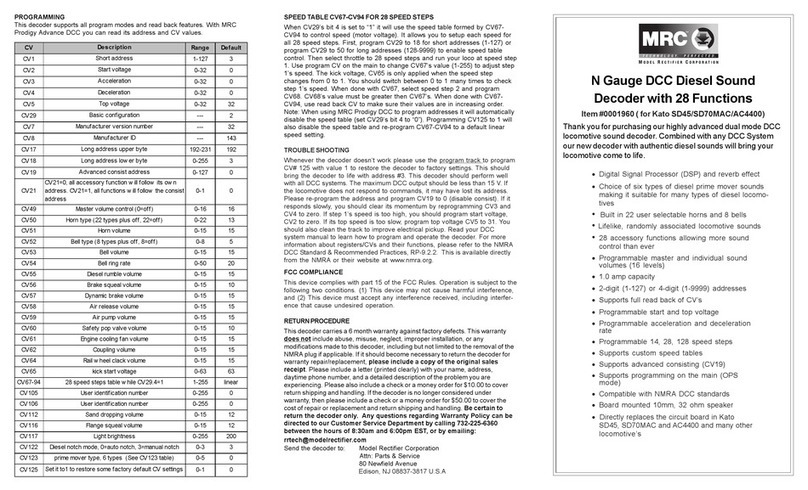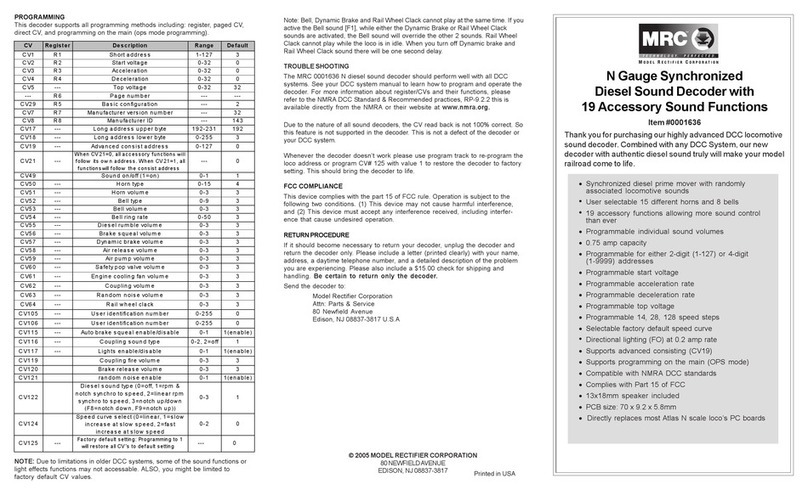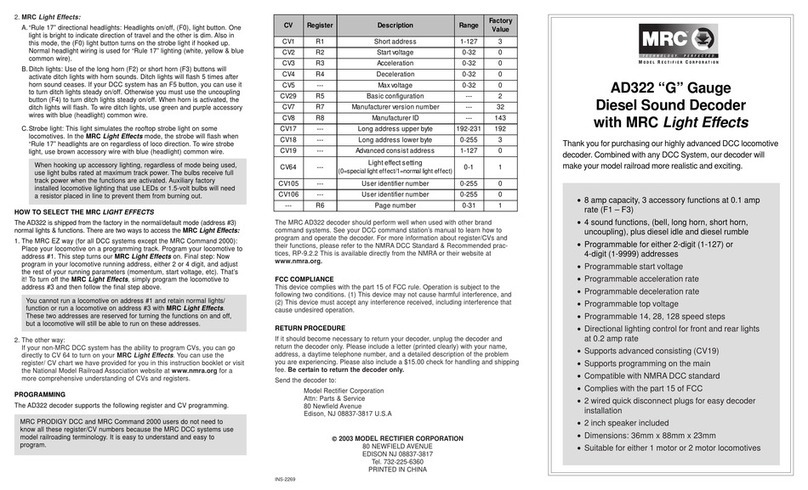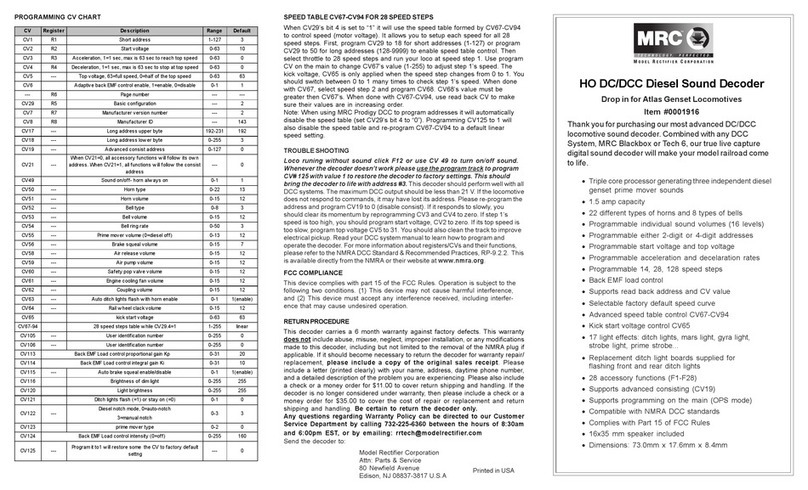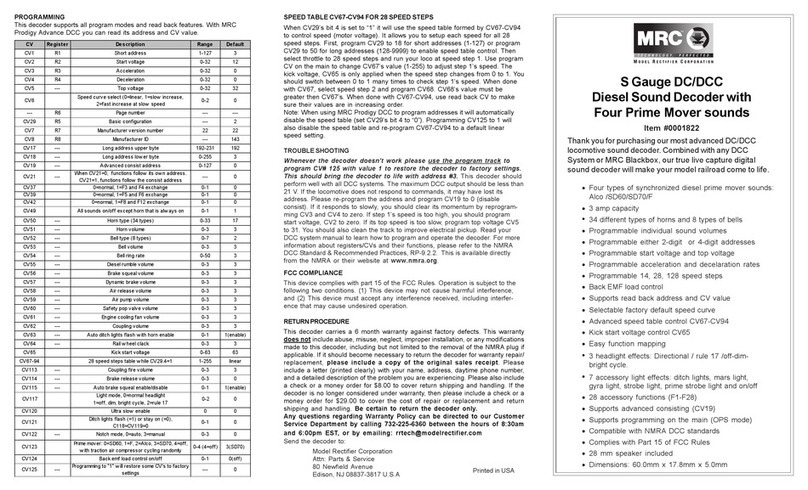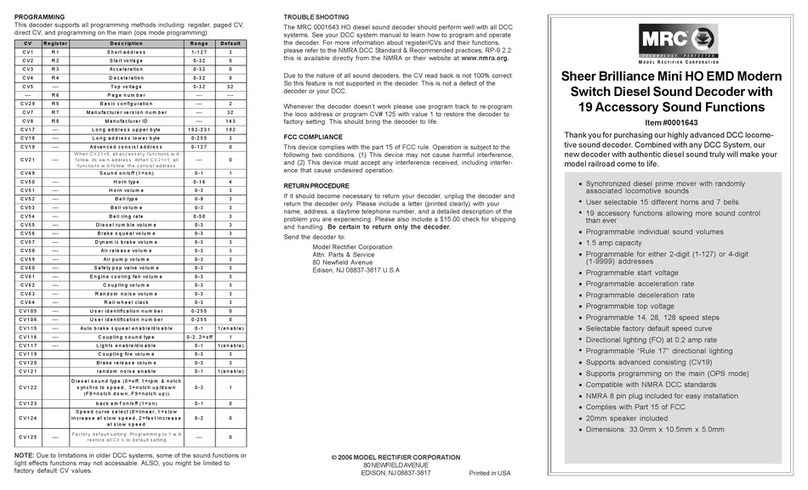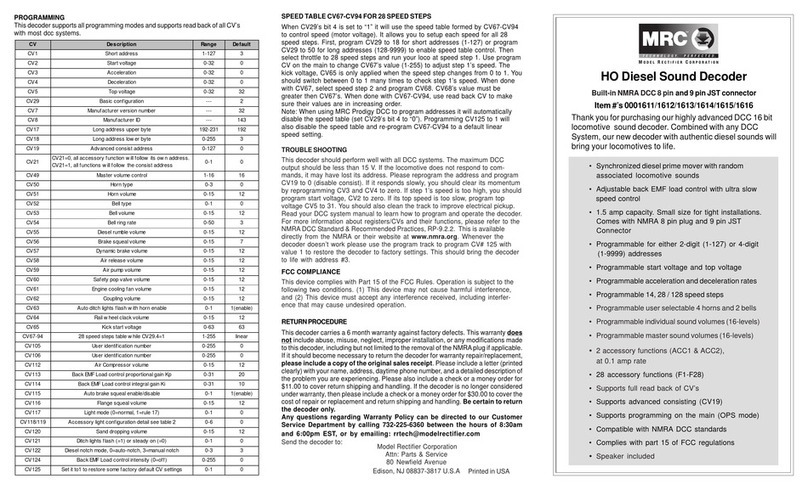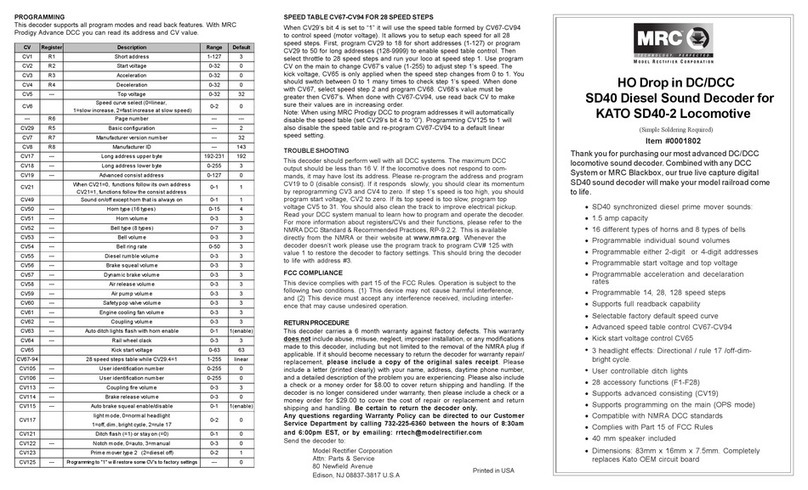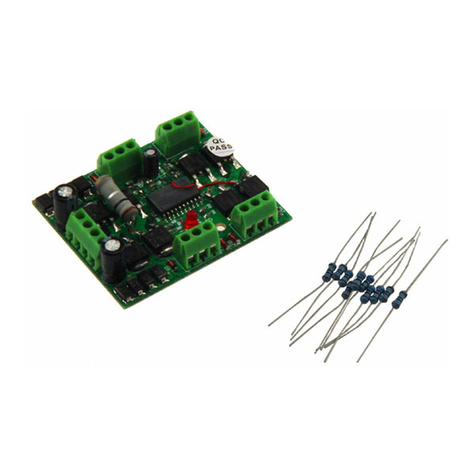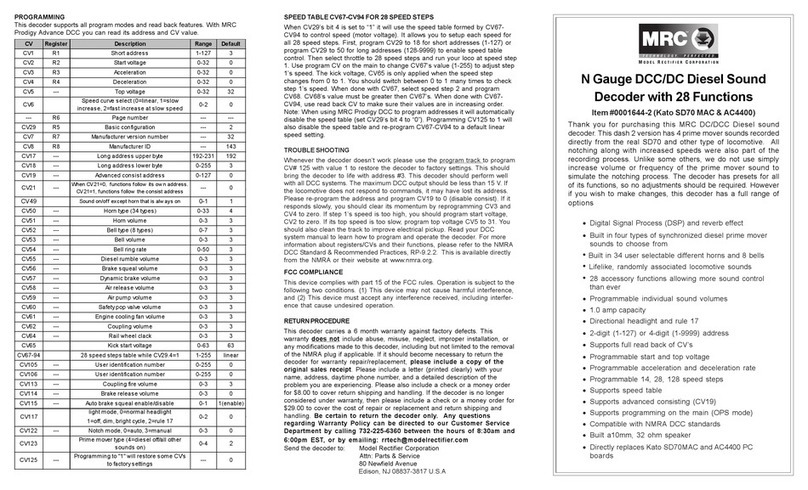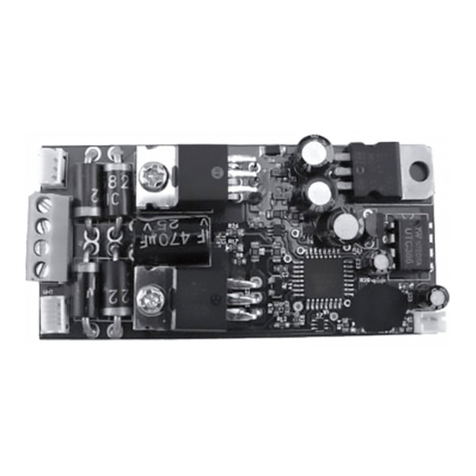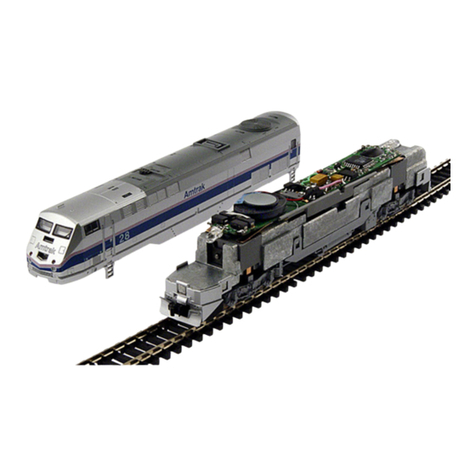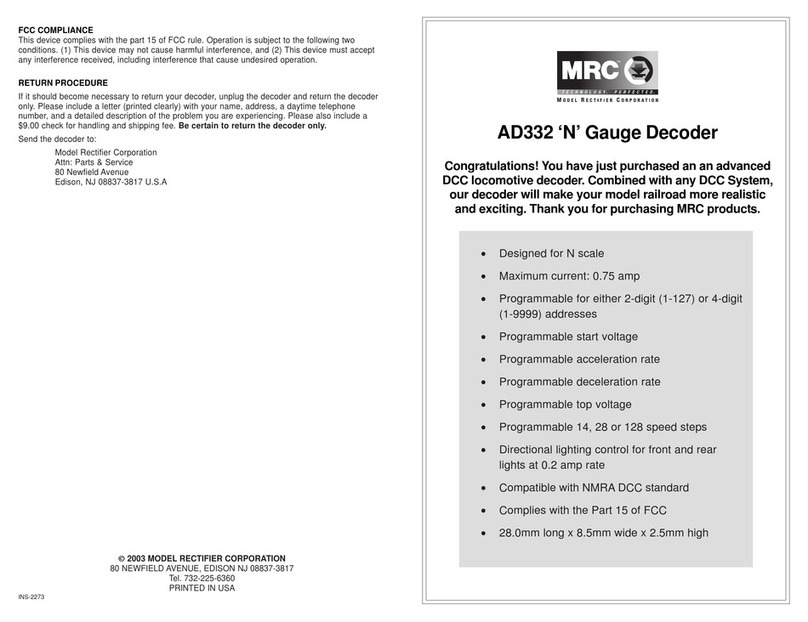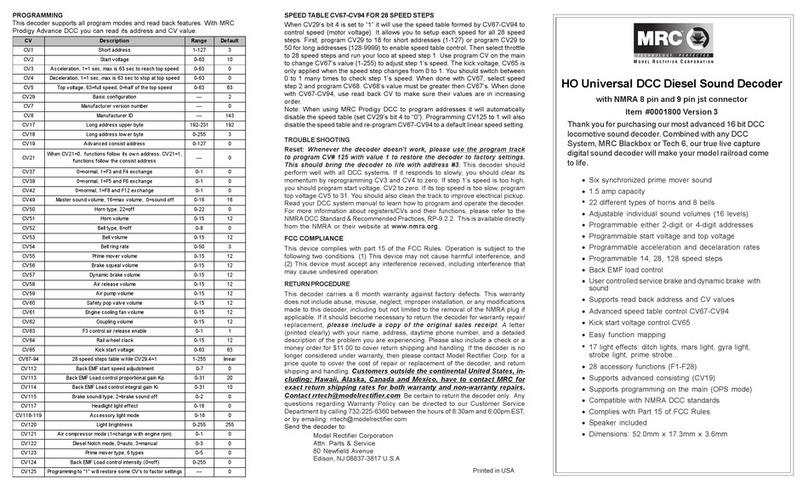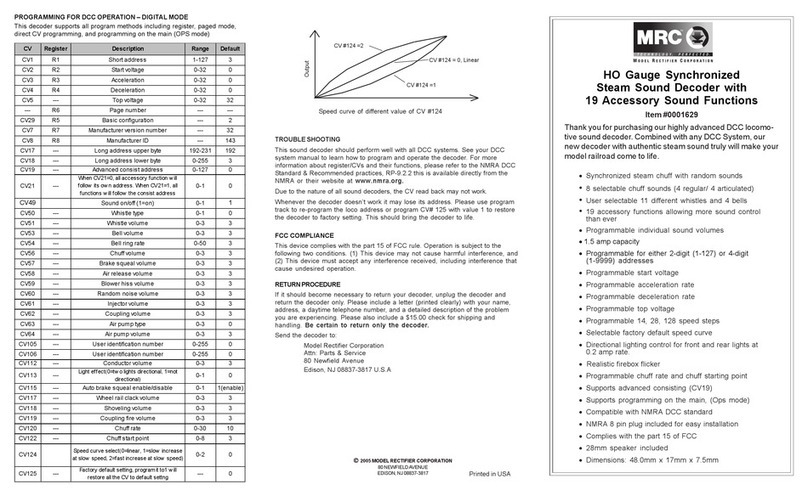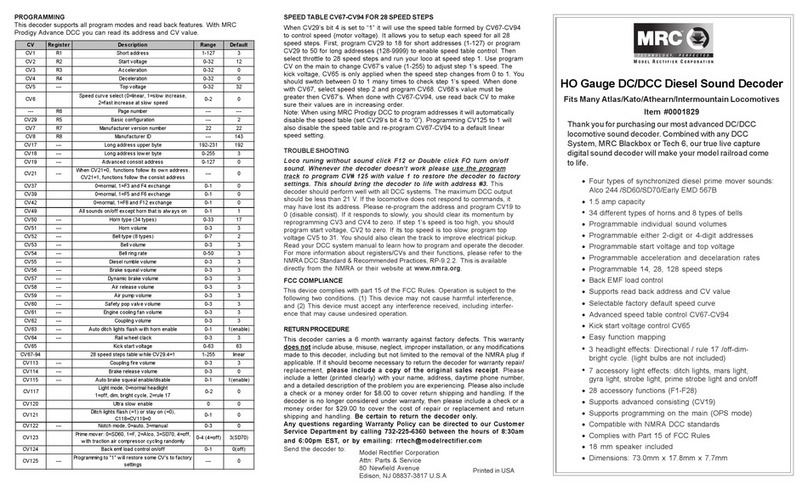
Sheer Brilliance N Gauge
Steam Sound Decoder with
19 Accessory Sound Functions
Item #0001637
Thank you for purchasing our highly advanced DCC locomo-
tive sound decoder. Combined with any DCC System, our
new decoder with authentic steam sound truly will make your
model railroad come to life.
•Synchronized steam chuff with random sounds
•12 selectable chuff sounds (4 regular/ 4 articulated)
•User selectable 12 different whistles and 4 bells
•19 accessory functions allowing more sound control
than ever
•Programmable individual sound volumes
• 1.0 amp capacity
•Programmable for either 2-digit (1-127) or 4-digit
(1-9999) addresses
•Programmable start voltage
•Programmable acceleration rate
•Programmable deceleration rate
•Programmable top voltage
•Programmable 14, 28, 128 speed steps
•Selectable factory default speed curve
•Directional lighting control for front and rear lights at
0.2 amp rate.
•Programmable chuff rate and chuff starting point
•Supports advanced consisting (CV19)
•Supports programming on the main, (Ops mode)
•Compatible with NMRA DCC standard
•Complies with the part 15 of FCC
•17mm speaker included
•Dimensions: 30.0mm x 10.0mm x 5.0mm
TROUBLE SHOOTING
This sound decoder should perform well with all DCC systems. See your DCC
system manual to learn how to program and operate the decoder. For more
information about register/CVs and their functions, please refer to the NMRA DCC
Standard & Recommended practices, RP-9.2.2 this is available directly from the
NMRA or their website at www.nmra.org.
Due to the nature of all sound decoders, the CV read back may not work.
Whenever the decoder doesn’t work it may lose its address. Please use program
track to re-program the loco address or program CV# 125 with value 1 to restore
the decoder to factory setting. This should bring the decoder to life.
FCC COMPLIANCE
This device complies with the part 15 of FCC rule. Operation is subject to the
following two conditions. (1) This device may not cause harmful interference, and
(2) This device must accept any interference received, including interference that
cause undesired operation.
RETURN PROCEDURE
If it should become necessary to return your decoder, unplug the decoder and
return the decoder only. Please include a letter (printed clearly) with your name,
address, a daytime telephone number, and a detailed description of the problem
you are experiencing. Please also include a $15.00 check for shipping and
handling. Be certain to return only the decoder.
Send the decoder to:
Model Rectifier Corporation
Attn: Parts & Service
80 Newfield Avenue
Edison, NJ 08837-3817 U.S.A
PROGRAMMING FOR DCC OPERATION – DIGITAL MODE
This decoder supports all program methods including register, paged mode,
direct CV programming, and programming on the main (OPS mode)
2005 MODEL RECTIFIER CORPORATION
80 NEWFIELD AVENUE
EDISON, NJ 08837-3817 Printed in USA
Speed curve of different value of CV #124
Output
CV #124 =1
CV #124 =2
CV #124 = 0, Linear
CV Register Description Range Default
CV1 R1 Short address 1-127 3
CV2 R2 Start voltage 0-32 0
CV3 R3 Acceleration 0-32 0
CV4 R4 Deceleration 0-32 0
CV5 --- Top voltage 0-32 32
--- R6 Page number --- ---
CV29 R5 Basic configuration --- 2
CV7 R7 Manufacturer version number --- 32
CV8 R8 Manufacturer ID --- 143
CV17 --- Long address upper byte 192-231 192
CV18 --- Long address lower byte 0-255 3
CV19 --- Advanced consist address 0-127 0
CV49 Sound on/off (1=on) 0-1 1
CV50 --- Whistle type 0-11 3
CV51 --- Whistle volume 0-3 3
CV52 --- Bell type 0-3 3
CV53 --- Bell volume 0-3 3
CV54 --- Bell ring rate 0-50 3
CV55 --- Chuff type(0-5=single chuff, 8-12=double
chuff) 0-12 0
CV56 --- Chuff volume 0-3 3
CV57 --- Brake squeal volume 0-3 3
CV58 --- Air release volume 0-3 3
CV59 --- Blower hiss volume 0-3 3
CV60 --- Random noise volume 0-3 3
CV61 --- Injector volume 0-3 3
CV62 --- Coupling volume 0-3 3
CV63 --- Air pump type 0-3 0
CV64 --- Air pump volume 0-3 3
CV105 --- User identification number 0-255 0
CV106 --- User identification number 0-255 0
CV112 --- Conductor volume 0-3 3
CV115 --- Auto brake squeal enable/disable 0-1 1(enable)
CV116 coupling sound type 0,2,3 3
CV118 --- Shoveling volume 0-3 3
CV119 --- Coupling fire volume 0-3 3
CV120 --- Chuff rate 0-30 ---
CV121 --- Chuff start point 0-5 ---
CV124 Speed curve select(0=linear, 1=slow increase
at slow speed, 2=fast increase at slow speed) 0-2 0
CV125 --- Factory default setting, program it to1 will
restore all the CV to default settng --- 0
CV21 --- 0
When CV21=0, all accessory function will
follow its ownaddress. When CV21=1, all
functions will follow the consist address
0-1












